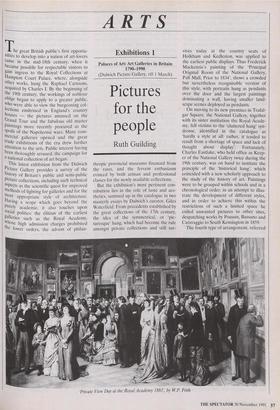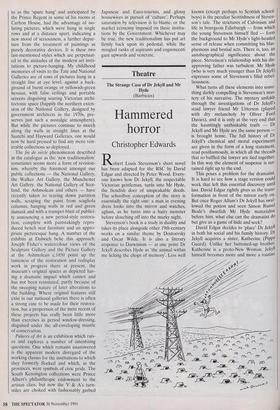ARTS
Exhibitions 1
Palaces of Art: Art Galleries in Britain 1790-1990
(Dulwich Picture Gallery, till 1 March)
Pictures for the people
Ruth Guilding
The great British public's first opportu- nities to develop into a nation of art-lovers came in the mid-18th century, when it became possible for respectable visitors to gain ingress to the Royal Collections at Hampton Court Palace, where, alongside other works, hung the Raphael Cartoons, acquired by Charles I. By the beginning of the 19th century, the workings of noblesse Oblige began to apply to a greater public, who were able to view the burgeoning col- lections enshrined in England's country houses — the pictures amassed on the Grand Tour and the fabulous old master Paintings more recently procured as the spoils of the Napoleonic wars. Many com- mercial galleries opened and the great trade exhibitions of the era drew further attention to the arts. Public interest having been thoioughly aroused, the campaign for a national collection of art began. This latest exhibition from the Dulwich Picture Gallery provides a survey of the history of Britain's public and semi-public Picture collections, including such technical aspects as the scientific quest for improved methods of lighting for galleries and for the most appropriate style of architecture. Having a scope which goes beyond the Purely academic, it also touches upon social politics: the elitism of the earliest galleries such as the Royal Academy, whose high admission charges prohibited the lower orders, the advent of philan-
thropic provincial museums financed from the rates, and the fervent enthusiasm evinced by both artisan and professional classes for the newly available collections.
But the exhibition's most pertinent con- tribution lies in the role of taste and aes- thetics, summed up in the catalogue in two masterly essays by Dulwich's curator, Giles Waterfield. From precedents established by the great collections of the 17th century, the idea of the symmetrical, or 'pic- turesque' hang, which had become the rule amongst private collections and still sur- vives today at the country seats of Holkham and Kedleston, was applied to the earliest public displays. Thus Frederick Mackenzie's painting of the 'Principal Original Room of the National Gallery, Pall Mall, Prior to 1834', shows a crowded but nevertheless recognisable version of this style, with portraits hung as pendants over the door and the largest paintings dominating a wall, having smaller land- scape scenes deployed as pendants.
On moving to its new premises in Trafal- gar Square, the National Gallery, together with its sister institution the Royal Acade- my, fell victims to the 'cluttered hang' syn- drome, identified in the catalogue as `hardly a style at all: rather, it tended to result from a shortage of space and lack of thought about display'. Fortunately, Charles Eastlake, who held office as Keep- er of the National Gallery twice during the 19th century, was on hand to institute the principle of the 'historical hang', which coincided with a new scholarly approach to the study of the history of art. Paintings were to be grouped within schools and in a chronological order, in an attempt to illus- trate the development of different styles, and in order to achieve this within the restrictions of such a limited space he exiled unwanted pictures to other sites, despatching works by Poussin, Bassano and Caravaggio to South Kensington in 1859.
The fourth type of arrangement, referred
'Private View Day at the Royal Academy 1881, by W.P. Frith to as the 'spare hang' and anticipated by the Prince Regent in some of his rooms at Carlton House, had the advantage of iso- lating pictures, which were hung in single rows and at a distance apart. indicating a new mood of seriousness, a further depar- ture from the treatment of paintings as purely decorative devices. It is these two last-mentioned styles which are perpetuat- ed in the attitudes of the modern art insti- tutions to picture-hanging. My childhood memories of visits to the Tate and National Galleries are of rows of pictures hung in a straight line at eye level, against a back- ground of burnt orange or yellowish-green hessian, with false ceilings and portable screens disguising soaring Victorian archi- tectonic space (happily the northern exten- sion of the National Gallery, designed by government architects in the 1970s, pre- serves just such a nostalgic atmosphere). But while the pictures continue to march along the walls in straight lines at the Saatchi and Hayward Galleries, one would now be hard pressed to find any more ven- erable collections so deployed.
The fin de siecle phenomenon described in the catalogue as the 'new traditionalism' sometimes seems more a form of revision- ism, whereby the foremost amongst our public collections — the National Gallery, the Walker Art Gallery, the Manchester Art Gallery, the National Gallery of Scot- land, the Ashmolean and others — have recently taken to tearing down partition walls, scraping the paint from scagliola columns, hanging walls in red and green damask and with a trumpet-blast of publici- ty announcing a new period-style restora- tion, complete with painstakingly repro- duced bench seat furniture and an appro- priate picturesque hang. A number of the exhibits at Dulwich belie this approach: Joseph Fisher's watercolour views of the Sculpture Gallery and the Picture Gallery at the Ashmolean c.1850 point up the tameness of the restoration and redisplay work in progress there at present, the museum's original spaces as depicted hav- ing a dramatic impact which cannot and has not been reinstated, partly because of the sweeping nature of later alterations to the building. Where original features still exist in our national galleries there is often a strong case to be made for their restora- tion, but a proportion of the most recent of these projects has really been little more than exercises in period window-dressing, disguised under the all-enveloping mantle of conservation.
Palaces of Art is an exhibition which rais- es and explores a number of interesting questions. One which remains unanswered is the apparent modern disregard of the working classes for the institutions to which they formerly flocked and which, in the provinces, were symbols of civic pride. The South Kensington collections were Prince Albert's philanthropic endowment to the artisan class, but now the V & A's turn- stiles are choked with fashionably garbed Japanese and Euro-tourists, and glossy housewives in pursuit of 'culture'. Perhaps saturation by television is to blame, or the market economy imposed on these institu- tions by the Government. Whichever may be true, the new traditionalism has put art firmly back upon its pedestal, while the mingled ranks of aspirants and cognoscenti gaze upwards and venerate.











































































 Previous page
Previous page